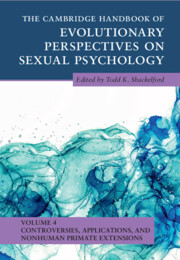Book contents
- The Cambridge Handbook of Evolutionary Perspectives on Sexual Psychology
- The Cambridge Handbook of Evolutionary Perspectives on Sexual Psychology
- Copyright page
- Contents
- Contributors
- Preface
- Part I Controversies and Unresolved Issues
- 1 The Female Sexual Orientation Spectrum in Evolutionary Perspective
- 2 The Evolution of Female Same-Sex Attraction
- 3 Male Bisexuality
- 4 Female Bisexuality
- 5 Masturbation in Primates
- Part II Applications to Health, Law, and Pornography
- Part III Nonhuman Primate Sexual Behavior
- Index
- References
2 - The Evolution of Female Same-Sex Attraction
from Part I - Controversies and Unresolved Issues
Published online by Cambridge University Press: 30 June 2022
- The Cambridge Handbook of Evolutionary Perspectives on Sexual Psychology
- The Cambridge Handbook of Evolutionary Perspectives on Sexual Psychology
- Copyright page
- Contents
- Contributors
- Preface
- Part I Controversies and Unresolved Issues
- 1 The Female Sexual Orientation Spectrum in Evolutionary Perspective
- 2 The Evolution of Female Same-Sex Attraction
- 3 Male Bisexuality
- 4 Female Bisexuality
- 5 Masturbation in Primates
- Part II Applications to Health, Law, and Pornography
- Part III Nonhuman Primate Sexual Behavior
- Index
- References
Summary
Same-sex attraction can impair the reproductive success of women, as it motivates them to direct their mating effort toward same-sex outlets from which offspring cannot be produced. This reproductive cost could translate into strong negative selection pressures, reducing this trait to a very low frequency in the population. Apparently, this did not happen, as more than one in ten women experience same-sex attractions. The current chapter discusses various theories that aim to solve the evolutionary paradox of the high prevalence of female same-sex attraction in the population, focusing on the weak negative selection pressures hypothesis and the male choice hypothesis. In the weak selection pressures hypothesis, factors present in ancestral human societies, such as arranged marriage and conformity to heterosexual marriage, have weakened negative selection pressures on same-sex attractions, allowing them to exist in high prevalence in contemporary societies. In the male choice hypothesis, men can potentially secure substantial reproductive benefits by having as partners women who experience same-sex attractions. In effect, they have evolved to prefer such attraction in women, with this male preference expected to translate into positive selection driving female same-sex attraction to higher prevalence in the population. Controversies arising from the male choice hypothesis are also discussed.
Keywords
- Type
- Chapter
- Information
- Publisher: Cambridge University PressPrint publication year: 2022



